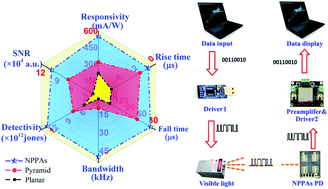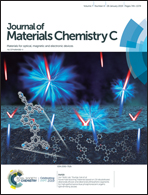High performance MoO3−x/Si heterojunction photodetectors with nanoporous pyramid Si arrays for visible light communication application†
Abstract
Molybdenum oxides have emerged as an important entity for optoelectronics due to their wide band gap and carrier-selective transportation property. However, there is little progress in the development of high-performance molybdenum oxide based photodetectors. Herein, a fast response and high detectivity (∼1.27 × 1013 Jones) photodetector based on the asymmetric heterojunction of MoO3−x/Si with a nanoporous pyramid array (NPPA) Si structure was reported. The device shows a broad linear dynamic range (LDR) over 116.6 dB and bandwidth over 50 kHz. Furthermore, the temperature-dependence of photoresponse was systematically investigated to probe the carrier transportation within the heterojunction. A model is proposed in which carrier diffusion dominates the photoresponse performance. Finally, the temperature-resistant NPPA based heterojunction photodetector is successfully integrated into a visible light communication system and its application as an optical signal receiver for transmitting texts is demonstrated. These findings suggest that our transition metal oxide based asymmetric heterojunction photodetectors have great application potential in optical communication.



 Please wait while we load your content...
Please wait while we load your content...